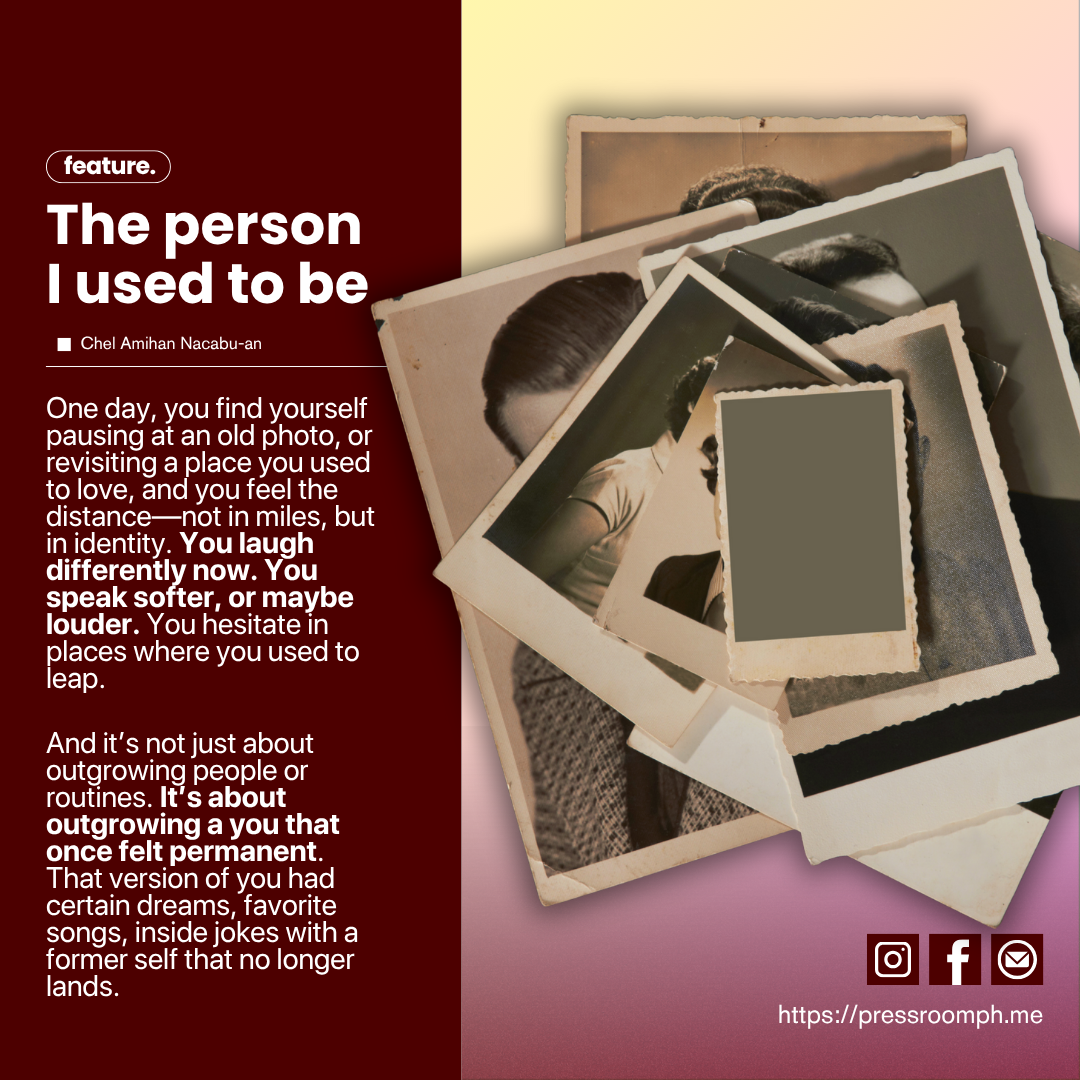There are days when you scroll through an old photo and barely recognize the person smiling back at you. Not because they look so different—but because you remember who you were when that photo was taken. Your habits, your voice, your dreams—the way you moved through the world.
And sometimes, that memory hurts more than any breakup.
We talk so much about grieving people, places, and endings. But what about the quiet grief of no longer being someone you once knew? The girl who was once fearless at seven or the boy who used to write poetry. The version of you who still believed that everything was possible.
Sometimes, we don’t miss the life who we once part of but rather who we were inside it.
Why it never stays
At the core of this grief is a psychological structure called the self-concept — the internal story we build about who we are. It’s shaped by what we do, what we value, how we’re seen, and who we think we’re supposed to be.
But here’s the catch: it never stays still.
As we move through new roles, environments, and relationships, our sense of self reshapes. And even though that’s normal — even healthy — it can still feel like loss. Like you’ve abandoned someone who once felt like home.
In her book The Defining Decade: Why Your Twenties Matter--And How to Make the Most of Them Now, psychologist Meg Jay explains: “When we make big life decisions, we often feel like we’re betraying the past version of ourselves. But that version wasn’t meant to last forever. We outgrow dreams, and that’s part of becoming real.”
According to research in developmental psychology, our self-concept especially shifts during big transitions: maybe because of graduation, heartbreak, career change, puberty, or even healing. That’s why we mourn that part of us — because these aren’t just life events, but identity deaths.
The saddest part? Most of the time, we don’t even notice the shift. You just wake up one day, look in the mirror, and realize you’ve stopped laughing the way you used to. You can’t remember the last time you liked that old hobby, or felt excited about things that once lit you up. The clothes no longer fit—not just on your body, but on your soul. And that's where it hits you: you’re not that person anymore.
Growing pains in disguise
Ever looked at an old journal entry and cringed, but also cried a little? That’s the emotional tug of what psychologists call identity shifts or the natural (but often painful) evolution of personality and perspective over time.
Our past selves don’t just vanish. They live like echoes in our decisions, our regrets, and our small daily rituals. That coffee order you can’t seem to drop. That playlist you never deleted. These are artifacts of old identities. And like real loss, it’s not always easy to move on from them. That's why we have that feeling to cling on to them — never wanting to let go.
But identity isn’t a straight line. It’s closer to a spiral — you come back to versions of yourself in new ways, older but softer, hurt but wiser. Each time you change, you carry the fingerprints of who you were.
So yes, it’s okay to miss the 2020 you. Or the you who had more faith, more energy, more fire. That doesn’t mean you’re regressing. It means you remember.
Telling a new story
In narrative therapy, psychologists help people rewrite their internal stories—not by erasing the past, but by integrating it. Instead of seeing former selves as failures or embarrassments, they become chapters. Essential ones.
When we grieve old versions of ourselves, we’re often stuck in a mental loop: “I was better then,” “I was happier before,” “I don’t know who I am now.” Narrative reframing lets us ask a new question: What did that version of me need?
Rather than seeing our old identities as mistakes or embarrassments, narrative therapy invites us to see them as necessary chapters that led to growth. Studies in narrative psychology have shown that people who learn to reinterpret past experiences through a more compassionate lens—what researchers call redemptive storytelling—tend to develop stronger resilience, clearer self-concept, and even improved mental health. Because when we shift from “I shouldn’t have been that person” to “That version of me got me through”.
You don’t have to become unrecognizable to grow. In fact, healing often looks like remembering differently — letting past versions of yourself become ancestors to who you are becoming.
Because you don’t owe anyone a brand new you.
A eulogy for every you
There’s something deeply sorrowful about realizing you've changed — not in the loud, cinematic way we often expect, but in the quiet undoing that happens over time. No one warns you how subtle it is. There’s no clear ending, no calendar date you can circle and say, “This is when I stopped being that person.” It just happens in a slow pace, in a slow fade.
One day, you find yourself pausing at an old photo, or revisiting a place you used to love, and you feel the distance—not in miles, but in identity. You laugh differently now. You speak softer, or maybe louder. You hesitate in places where you used to leap.
And it’s not just about outgrowing people or routines. It’s about outgrowing a you that once felt permanent. That version of you had certain dreams, favorite songs, inside jokes with a former self that no longer lands. There’s grief in that—grief that creeps in during the most mundane moments: when your hands don’t reach for the same things, when your smile doesn’t form the same way, when your silence now feels more familiar than your joy. It’s the kind of loss you can’t easily name, because technically, nothing happened.
And maybe, just maybe, you don’t have to let them go completely. Maybe you can carry them — gently — into who you are now. Not as ghosts — but as witnesses.






